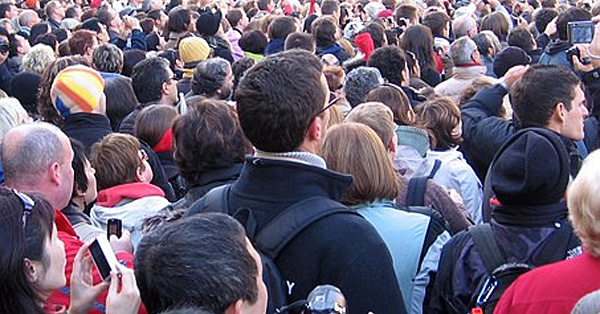As we read/watched/listened to the coverage of political events this past weekend, there was a lot of time spent on the significance of crowd size in Washington, DC. It got us thinking how much difference it really makes for these estimates to be accurate. The one neutral entity with the best chance of coming close to determining crowd size, the National Park Police, was banned by congress over 20 years ago from spending money to conduct these estimates. There are scientific methods for estimating crowd size using wide-angle, high resolution images that can be studied in relation to the ground area covered. However these type of estimates, if they are conducted at all, only come out well after the event takes place. That leaves the event organizers themselves and media outlets as the estimating “authorities” at the moment the event occurs. Naturally, there is a built-in bias for the event organizer to always overestimate. As well, media outlets will publish estimates (high or low) that tend to support the politics of the readership of that outlet. But even if these estimates were always accurate, when does crowd size have meaning?
Here are two examples from over the weekend:
The Inauguration – Whether the crowd estimate was 1 million people or 10 people, the new President will still be the new President on Monday morning when work begins. A large or small crowd at the ceremony will not change what is going to happen in the coming days/weeks/months/years of a new administration, Democrat or Republican. It is true that a big crowd can be a comforting show of support, but the agenda of a new President, crafted months before the inauguration ceremony, is not going to change as a result of crowd size. In this particular example therefore, there is little reason to argue over it no matter which side you are on.
The Woman’s March on DC – The context for this example is fundamentally different from that of the inauguration. A strong showing in events of this nature can make a difference. Even without an accurate estimate, the crowd size was clearly “large” for this event. The big question now is what conclusions regarding the marchers’ messages can or should be drawn from this crowd size. The Mission Statement for the march begins with a strong statement about the rhetoric of the past election cycle. It would appear from this part of the mission statement and media coverage of the protest’s speakers there is a very large and unified voice of opposition to the new President among women. But this does not reflect the voting results of the election. First, Mr. Trump won the election despite the fact the majority of all voters (53%) were female. Second, white women, who accounted for 70% of the female vote, overwhelmingly voted for President Trump (53% – 43%). It was only the near-complete opposition to Mr. Trump in the votes of Black and Latino women (13% of the electorate) that gave the overall female popular vote to Secretary Clinton.
So what is the proper way to reconcile the actual voting results with the significance of the size of the march? The complete mission statement from the organizers of the march is laudable and includes concerns about rights that are valid in any context, not just in the aftermath of this election. Therefore, it may not be entirely correct to presume that every participant in the march was there solely in opposition to the new President or even voted in the election. The large crowd size in this example indicates meaning beyond a simple anti-election rally.

4 Responses
Obama’s crowd at his inauguration may have been bigger, but his fan base was also comprised largely of people who aren’t required to be at work at noon on a Friday. I would imagine also that the fear of violence from the left kept many away from Trump’s inauguration. I know this was the cause of many of my friends refusing to go to his rallies during the campaign, despite their support.
Regarding the “Women’s March” I don’t think the turnout is significant, I think the amount of money George Soros and his ilk spend subverting American politics is obscene. I read this morning he is tied to 50 different organizations that planned and executed the transportation and organization of these “marchers.”
Good point about the inauguration being on a work day. In all fairness though, there was unique historical significance to the 2009 inauguration. Regarding the Woman’s March, Madonna and others may have dulled some of the positive meaning from the crowd size. Look for a forthcoming blog post on this aspect.
There’s an interesting fact related to the Women’s March on DC that dove-tails with the women voter statistics – those that lost. The women in the march had long expected Ms. Clinton to win. As such, they already had plans to be in Washington to celebrate the first woman president – reserved hotel rooms, big party plans, etc., much like the DNC victory fireworks that were ordered many months before the election. A pity party march was a therapeutic replacement to leverage the planning. Spoiled children need time to scream and stomp their feet when their toys are taken away.
You bring up a good point about all the pent-up anticipation and premature plans made for a historically unique inauguration just like in 2009. All that energy has to go somewhere I suppose. It might have been more strategic to be patient, and reserve the march for when the President actually does something thing they don’t like. The big guns may have been fired a bit too early.